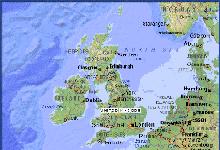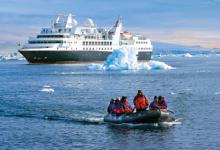Recently Viewed Cruises
- Silver Explorer, Voyage 7311 ex Greenock to BergenAdd to favourites
- Magnifica, Germany UK Ireland Netherlands ex Hamburg ReturnAdd to favourites
- Discovery, Celtic Explorer ex Liverpool to HarwichAdd to favourites
- Whisper, Voyage 4309 ex Southampton to CopenhagenAdd to favourites
- Voyager, British Isles & Chelsea Flower Show ex Portsmouth ReturnAdd to favourites
- Catch up on Cruising: Latest cruise news in bite size
- Royal Caribbean International raises the bar
- Classy Astor fills gap in market
- Oceanic Discoverer
- Ab Fab Oosterdam
- Frequently Asked Questions
-
Silver Explorer, Voyage 7311 ex Greenock to Bergen
Nights 12 Ship Silver Explorer Star Rating Specialty Departs Greenock-Glasgow, Scotland Sailing 2013: 23 May Ports of Call Greenock-Glasgow, Holyhead, Dublin, Belfast, Iona, St Kilda, Tórshavn, Faroe Islands More Fair Isle Shetland Islands, Lerwick, Isle of Noss, Bergen Select a sailing date for approximate pricing.
Prices are per person, twin share. When booking please check current cruise fare and inclusions. Prices are indicative only, subject to currency fluctuations and may change at any time without notice.
12 Night Cruise sailing from Greenock to Bergen aboard Silver Explorer.
Silversea's purpose-built Silver Explorer expedition ship (formerly the Prince Albert II) has been designed specifically for navigating waters in some of the world's most remote destinations, including both of earth's polar regions. A strengthened hull with a Lloyd's Register ice-class notation (1A) for passenger vessels enables Silver Explorer to safely push through ice floes with ease. A fleet of Zodiac boats allows Silversea Expedition guests to visit even the most off-the-beaten path locations and an expert Expedition Team provides insight and understanding to each unforgettable Silver Explorer cruise adventure.
Onboard, savour a convivial cosmopolitan ambience and many special amenities usually found only on larger ships, including a spacious Library with an Internet Cafe, boutique shopping, a full-service spa, beauty salon, fitness centre, sauna and two top-deck whirlpools. Prince Albert II even features live evening entertainment and The Humidor, where connoisseurs can enjoy the finest cigars and cognacs - diversions offered by no other expedition ship.
Highlights of this cruise:
Greenock
In the days when Britain still ruled over an empire, Glasgow pronounced itself the Second City of the Empire. The term "Clyde-built" (from Glasgow's River Clyde) became synonymous with good workmanship and lasting quality. Glasgow had fallen into a severely depressed state by the mid-20th century, but during the last two decades of the 20th century the city cleaned up and started looking forward. Modern Glasgow has undergone an urban renaissance: a booming cultural life, stylish restaurants, and an air of confidence make it Scotland's most exciting city. Glasgow is particularly remarkable for its architecture and some of the most exciting museum collections outside London.
Dublin
In his inimitable, irresistible way, James Joyce immortalized the city of Dublin in works like Ulysses and Dubliners. He claimed to have chosen Dublin as the setting for his work because it was a "center of paralysis" where nothing much ever changed. What would he make of Temple Bar-the city's erstwhile down-at-the-heels neighborhood, now crammed with restaurants and hotels? Or of the city's newfound status as a bustling hub of the European economy? Yet despite all these advances, traditional Dublin is far from buried. The fundamentals-the Georgian elegance of Merrion Square, the Norman drama of Christ Church Cathedral, the foamy pint at an atmospheric pub-are still on hand to gratify. Most of all, there are the locals themselves: the nod and grin when you catch their eye on the street, the eagerness to share a tale or two, and their paradoxically dark but warm sense of humor.
Belfast
The ancient city of Belfast lies nestled into the rugged coast of Northern Ireland where the River Lagan meets the sea. The name itself reflects this position; it is a translation meaning "sandbank fjord". Offshore, the green water of the North Channel churns, separating the Irish coast from Scotland by less than 40 miles (64 km). Inland lie the forever-green lands of Ulster Province.
According to historians, the capital of Northern Ireland saw its earliest settlement around a substantial fortress before the Middle Ages. Many battles raged on the cobblestone streets of Belfast. When French Huguenots arrived in the 17th century, they brought weapons and the knowledge of "advanced" technology with them. They introduced the manufacture of fine linens that, along with shipbuilding, literally put Belfast on the world map. The Huguenots also brought with them a strong faith and great interest in the arts. They built churches and established institutions of higher learning, all of which helped the city gain importance.
Today, Belfast is a robust metropolis, popular with travellers who come to discover the city's physical beauty and renewed tranquillity. The country's politics are quite complicated and suggest an in-depth study for those with a keen interest. Nearly one third of Northern Ireland's population, about 400,000 lives in the city, drawn by its beautiful setting and employment opportunities. The city is prosperous, even though linen production and shipbuilding are no longer booming. Residents and tourists alike enjoy shopping along trendy Donegall Place and visiting the numerous pubs along The Golden Mile.
Lerwick
A Scandinavian heritage gives the islets that make up Shetland an ambience different from that of any other region of Scotland. For mainland Scots, visiting this archipelago is a little like traveling abroad without having to worry about a different language or currency. Shetland, with its ocean views and sparse landscapes-trees are a rarity because of ever-present wind-seems remote, even more so than neighboring Orkney. However, don't let Shetland's desolate countryside fool you: it has a wealth of historic interest and is far from being a backwater island. Oil money from its mineral resources and its position as a crossroads in the northern seas for centuries have helped make Shetland a cosmopolitan place.
Bergen
A place of enchantment, Bergen's epithets include "Trebyen" (Wooden City), for its many wooden houses, "Fjordbyen" (Gateway to the Fjords), for obvious reasons, and "Regnbyen" (Rainy City), for its 200 days of rain a year. Most visitors quickly learn the necessity of rain jackets and umbrellas, and Bergen has even handily provided the world's first umbrella vending machine. Norway's second-largest city was founded in 1070 by Olav Kyrre as a commercial center. The surviving Hanseatic wooden buildings on Bryggen (the quay) are topped with triangular gingerbread roofs and painted in red, blue, yellow, and green. Monuments in themselves (they are on the UNESCO World Heritage List), the buildings tempt travelers and locals to the shops, restaurants, and museums inside. Evenings, when Bryggen is illuminated, these modest buildings, together with the stocky Rosenkrantz Tower, the Flryen, and the yachts lining the pier, are reflected in the water and combine to create one of the loveliest cityscapes in northern Europe.







